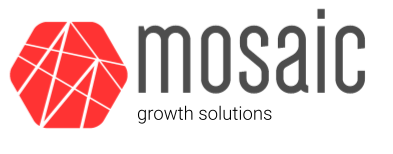A major part of Mosaic’s growth marketing assessment is the marketing maturity analysis in which we seek to understand and benchmark the sophistication of an organization’s marketing-led growth strategy and capabilities as well as that of its direct competitors. Doing this is the first step in understanding how much opportunity an organization has to build, optimize, and scale a marketing-led growth motion. It also helps to identify specific areas where the company can improve performance and see short-term impact on growth.
Since we don’t have access to detailed performance reporting or internal insights for the client’s competitors, we maintain a purely external perspective during this portion of the evaluation for our client as well. We leverage publicly available information to understand the prospect experience for the client and its competitors, resulting in a more meaningful “apples-to-apples” comparison.
Marketing Maturity Analysis
Mosaic evaluates 6 different components of a successful demand generation strategy: organic search, paid search, social media, website, brand authority, and content. Below are some of the considerations. Each component is assigned a score of 1-5. The below table (Figure 1) provides a very high-level overview of what we consider in our scoring.
Most companies we evaluate fall in the moderate maturity range. For these companies, the go-forward strategy involves testing, learning, optimizing, and, ultimately, scaling. For immature companies, we focus on more foundational elements of building the operational frameworks and processes required to run a successful marketing-led motion. We see the most potential for transformational growth when the company, as well as the industry more broadly, has low maturity.
| Organic Search (1-5) | Paid Strategy (1-5) | Social Media (1-5) |
| Keyword strategy Technical SEO issues Content strategy/keyword alignment Mobile responsiveness On-page tactics |
Investment level Campaign structure Keyword matching strategy Ongoing campaign mgmt Clear CTAs & tracking |
Frequency & variety of posts Leadership/org activity Size of audience Audience engagement Potential monetization path |
| Website (1-5) | Brand Authority (1-5) | Content Marketing (1-5) |
| Overall look & feel UX & ease of navigation Built for multiple personas Clear calls to action Effective messaging |
Mix of site traffic sources Direct traffic & backlinking PR strategy Thought-leadership Share of Search |
Variety of channels/types Frequency/consistency Unified strategy and “story” Uniqueness of content and perspectives presented |
Competitive Analysis
In addition to assessing the client’s marketing maturity, it is valuable to evaluate the marketing maturity of direct competitors and, more broadly, the industry and/or relevant SaaS vertical as a whole. Not only does this provide context, but it also surfaces low-hanging opportunities to gain market share by implementing a strategy or tactic that is even slightly better than what exists in the market.
As part of our competitive analysis, we look more closely at demand generation tactics and top-of-the-funnel performance indicators.
| Metric | Description |
|---|---|
| Site Authority | Based on a scoring methodology out of 100, site authority reflects domain quality and has a direct impact on organic search performance (higher is better). |
| Linking Domains | This metric captures the quantity of other websites that link back to the company’s website, a factor in determining site authority. |
| Organic Keyword Volume | An estimated volume of keywords for which the website shows up within organic search results. |
| Organic Traffic | The estimated number of monthly users driven to the website by organic search. |
| % Branded | The proportion of organic search traffic that is driven by branded keywords. |
| Paid Traffic | The estimated number of monthly users driven to the website by paid search. |
| Average Rank | The website’s average rank in Google for keywords that are shared across the entire competitive set (lower is better). |
| Share of Search | This metric is the % of total branded searches the individual company has vs. the industry as whole which correlates to market share. |
These data points allow us to understand which competitors have invested effectively in both organic and paid channels. For example, a situation where organic keyword volume and traffic are low for all competitors could mean that a focused investment on improving organic search performance could have significant impact on demand generation.
Looking more closely at what the competitors are (and, more importantly, are not) doing from a marketing perspective ensures clients are adopting the tactics where competitors have proven success. Identifying areas of lower maturity and/or ineffective execution can surface highly actionable, low-hanging opportunities to easily outperform the competition.

Recent Comments